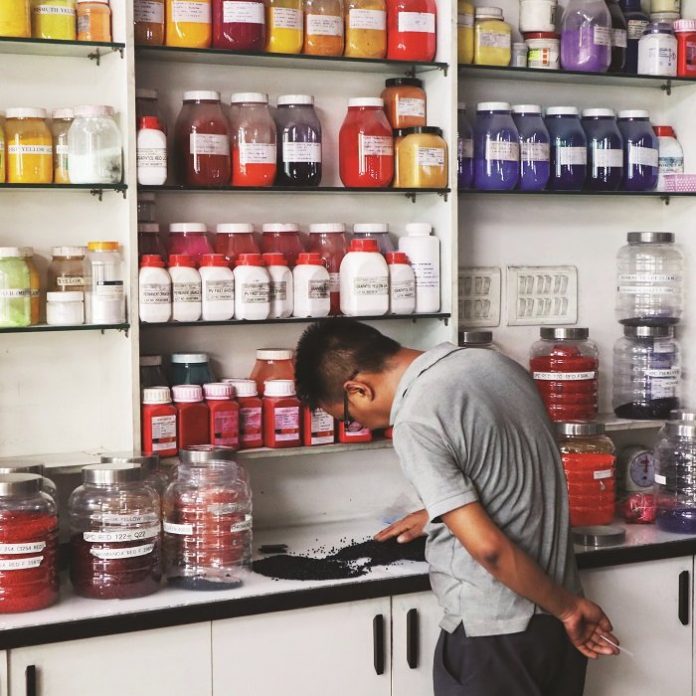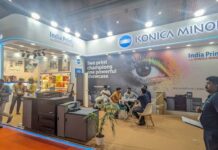We had an opportunity to visit the Alok Technology Incubation Centre in South Delhi’s Okhla Industrial Area a few days ago. The creator of this platform is Alok Masterbatches, a Rs. 400 crore (US$ 60 million) company with six masterbatch manufacturing plants including five in India and one in Latin America. The newest plant in Silvassa has a capacity of manufacturing 5,000 tons a month. ATIC is the technology platform that it established about five years ago to foster a much-needed R&D culture in order to come up with technology solutions for its customers.
At ATIC, Vikram Bhadauria, who leads the technology team of the company as a whole, introduced us to vice president of technology Dr Nitin Joshi and showed us around the center consisting of a research lab, a lab with advance measuring instruments, a mixing lab or kitchen for making experimental masterbatches, and finally a small extrusion blown film machine for producing prototype films and structures.
Bhadauria says, “We set up this industry 25 years ago, and we set up ATIC 5 years ago with the core philosophy of adding good to everything whether it is relationships or plastics. Earlier we built R&D teams that after six months used to get coopted by production. We wanted to separate the R&D and do something scientific and new without any financial targets—to work on something new to build new products and new product technologies, not only masterbatches, but to really think of something new.
ATIC is an open technology platform for anyone to come and use it for help in finding solutions for their plastics applications—anything and everything for current and future needs. After we started with a fresh batch of engineers straight off the campus, customers slowly came to us for a variety of reasons – perhaps they had seen something in Europe or the US and asked if it could be produced here. Global suppliers came to us looking for Indian partners.”
ATIC is a success story that has won awards for its innovative R&D solutions. Bhadauria explains its mission, “In India we see that there is shortage of durable products and while plastics offer many solutions, keeping our conditions in mind we have to make sure these are safe, sustainable and also affordable.”
He explains that the masterbatches (or additives) developed by ATIC are used in several key areas of plastic management such as UV and IR radiation, electromagnetic interference shielding, density modification process improvement and heat management. “Thus you can use plastic to make tent material for the Indian army which works in cold conditions, in a snowy environment and just by flipping it over, in hot and desert conditions. This is done just by heat management. There is electrical management of plastics also, such as anti-static, which is useful for defense applications such as explosives and EMI shielding (electromagnetic interference shielding) for all kinds of electronic products and instruments. With density management of plastics we can make them lighter and with thermal management of plastics, we can have plastics conducting heat.”
Bhadauria, like several leading Indian plastic industry professionals, was educated at one of the finest chemical and plastic engineering schools in the world, at the University of Massachusetts at Lowell, which is also partnering the PlastIndia Foundation in building its Plastics University in Vapi, Gujarat. He gives examples of some the notable R&D successes of the company, “In 2003, a farmer contacted us who had used some films in Israel and he wanted help in producing some special mulch films for agriculture for which he foresaw a big market in India. Apart from seeking our center’s help, he used various consultants and testing facilities including Central Institute of Plastic Engineering (CIPET) and even brought some ingredients from Europe.
“Ultimately, we helped him produce a film that worked as well, if not better, than the Israeli film. In 2015, this agricultural film won us the innovation award. Now from one machine he has four machines to produce these films – from being a farmer he has become an industrialist.”

It is clear that in its time of trouble plastics will have to be driven by sustainability. This is well understood by Bhadauria and he is articulate about it, “On plastic waste – there are three pillars to this: industry, government and society.” Right now there is a bit of noise around the issues and when the situation evolves Bhadauria expects the discussion to become more scientific.
Oxo-biodegradable plastics
Ironically the government has banned only plastic use less than 50 microns, which is generally a single plastic structure and which should be easy to recycle. The real challenge is to produce multi-layer plastics of multi-polymers that do not have to be merely down-cycled into inferior products. The rules of a circular economy dictate that materials after use and re-use are recycled into products of equivalent or greater value first and only then down-cycled. He adds that even with many regular oxo-biodegradable plastics there is still a question mark, because with these one piece of plastic merely breaks down into a million pieces. Plastic, which has a molecular weight of 500,000 Dalton (Da), takes about 70 to 80 years to degrade and the body cannot digest it.
Bhadauria tells us about ATIC’s successful partnership with Willow Ridge, a leading manufacturer of oxo-biodegradable additives. Willow Ridge has a very unique oxo-biodegradable technology that transforms plastic films into mulch in 6 to 8 months, which is appropriate for many applications.

The Willow Ridge technology reduces the molecular weight of plastic from 500,000 Da to below 4,000 Da. Anything organic, and plastic is organic, that is below 4,000 Da becomes bio-digestable – if a fish eats it, an animal or human eats it, it is digested and thrown out. The enzymes attack it. Willow Ridge has developed a technology that makes sure the degradation goes beyond 4,000 Da.
Taking on the multilayer plastic recycling challenge
Bhadauria also tells us about how ATIC is working with three technologies – one for making oxo-biodegradable plastics and the other with which we can recycle a multi-layer structure. This is a 5-layer multi-layer structure that is recyclable – that will be laterally recyclable. It could be used for instant noodle or biscuit pouches, by adding an additive masterbatch to help recycle multi-layer structures. “We were approached by a partner and we have developed a product for which we have filed a patent and which will be recyclable.
A third product is anti-static additive for films used for explosives or electrical and electronics. “Our additive makes the plastic permanently anti-static. This product can be used for the packaging of electronics,” says Bhadauria.
We ask him about some of the cost issues and as in all his calm and articulate responses, he says, “The customer will pay, especially when the government comes in with multi-layer legislation. This happened in the white goods industry when self-regulation and not legislation was needed for eliminating heavy metals in any plastic that they use. The self-regulation came from Samsung, LG and others. The inputs are available; it is up to the industry and society and the government to get their act together but it is obvious that the industry can lead; all it takes is one leader.
“If Patanjali says tomorrow that their packaging is laterally or upwardly recyclable, everyone will jump on the bandwagon. For the past 20 years the plastic industry has been saying that plastics don’t pollute, people do. This is so similar to the National Rifle Associations slogan that says ‘Guns don’t kill people, people kill people.’ Our blaming the public is being associated with such a negative slogan that it has set the plastic industry back.” It is clear Bhadauria has some but may be not all the answers, but he has built something that can contribute to our curiosity, our science and our ability to take on the future.
How much do you really know about packaging
What is the unit for the molecular weight of plastics?
The unit of MW for polymers is the same as that of non-polymeric compounds; it is g/mol (or Dalton, Da). This is very simple in non-polymeric compounds (e.g., NaCl salt), but in the case of polymers it is so complicated as they include long macromolecular chains with various length size. It is more common to state the MW of polymers as a statistical measure and degree of polymerization (DP), which is the average number of monomers in the polymer sample. Therefore, DP is the average MW of polymer divided by the MW of monomer.
Answered by Saeed Doroudiani, PhD, P.Eng., chemical engineer, Materials/Polymer Scientist on 29 July 2016 on Quora. · Upvoted by Miranda Marcus, applications engineer at EWI specializing in Plastic Joining · Author has 1.6k answers and 1.4m answer views










